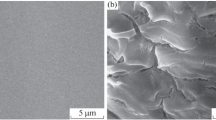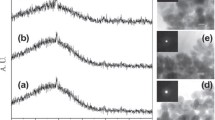A method is proposed for obtaining radiocontrast bioglass by pyrolysis of organic solutions containing tetraethoxysilane, tributyl phosphate, sodium oleate, and calcium oleate in turpentine and also an extract in a benzene solution of tri-n-octylamine. This method makes it possible to obtain tungsten-containing radiocontrast glass as a powder or coating on different porous carriers.






Similar content being viewed by others
Notes
Here and below, weight content, %, unless otherwise stipulated
References
N. V. Buchilin and E. E. Stroganova, “Sintered glass-ceramic materials based on calcium-phosphate glasses,” Steklo Keram., No. 8, 8 – 11 (2008); N. V. Buchilin and E. E. Stroganova, “Sintered glass-ceramic materials based on calcium-phosphate glasses,” Glass Ceram., 65(7 – 8), 256 – 259 (2008).
N. V. Buchilin, Porous Calcium Phosphate Glass-Ceramic Materials for Bone Endoprostheses, Author’s Abstract of Candidate’s Thesis [in Russian], RKhTU, Moscow (2010).
Q. Z. Chen, I. D. Thompson, and A. R. Boccacini, “45S5 Bioglass-derived glass-ceramic scaffolds for bone tissue engineering,” Biomaterials, 27, 2414 – 2425 (2006).
L. L. Hench, “The story of Bioglass,” J. Mater. Sci.: Mater. Med., 17, 967 – 978 (2006).
L. L. Hench, “Bioceramics: from concept to clinic,” J. Am. Ceram. Soc., 74(7), 1487 – 1510 (1991).
L. L. Hench, An Introduction to Bioceramics, World Scientific (1993).
L. L. Hench, “Bioceramics,” J. Am. Ceram. Soc., 81(7), 1705 – 1972 (1998).
S. K. Nandi, B. Kundu, and S. Datta, “Development and applications of varieties of bioactive glass compositions in dental surgery, third generation tissue engineering, orthopaedic surgery and as drug delivery system,” Biomater. Appl. Nanomed. (2011), pp. 69 – 116.
T. J. Webster, E. A. Massa-Schlueter, J. L. Smith, and E. B. Slamovich, “Osteoblast response to hydroxyapatite doped with divalent and trivalent cations,” Biomaterials, 25(11), 2111 – 2121 (2004).
S. Deb, S. Abdulghani, and J. C. Behiri, “Radiopacity in bone cements using an organo-bismuth compound,” Biomaterials, 23(16), 3387 – 3393 (2002).
J. Aberg, E. Pankotai, G. H. Billstrom, et al., “In vivo evaluation of an injectable premixed radiopaque calcium phosphate cement,” Int. J. Biomater., 2011, 7 (2011).
X.Wang, J. Ye, and Y.Wang, “Influence of a novel radiopacifier on the properties of an injectable calcium phosphate cement,” Acta Biomater., 3(5), 757 – 763 (2007).
J. Aberg, H. B. Henriksson, H. Engqvist, et al., “Biocompatibility and resorption of a radiopaque premixed calcium phosphate cement,” J. Biomed. Mater. Res. A, 100(5), 1269 – 1278 (2012).
A. P. Syritskii, A. A. Kishmishyan, M. B. Romanovskii, et al., Glass Mainly for Fillers of Composite Stomatological Materials, Pat. 2028980 RF, Application No. 5064553_33, July 13, 1992 [in Russian], publ. Feb. 20, 1995.
A. M. Pelesh, N. P. Anyaikina, Yu. N. Isobello, et al, Radiocontrast Glass, Pat. 13965 Belarus, Application No. 20090701, Dated May 14, 2009 [in Russian], publ. Feb. 28, 2011.
D. Mohn, M. Zehnder, T. Imfeld, and W. J. Stark, “Radio-opaque nanosized bioactive glass for potential root canal application: evaluation of radiopacity, bioactivity and alkaline capacity,” Int. Endod. J., 43(3), 210 – 217 (2010).
A. L. Popov, N. M. Zholobak, O. I. Balko, et al., “Photo-induced toxicity of tungsten oxide photochromic nanoparticles,” J. Photochem. Photobiol., B. Biology, 178, 395 – 403 (2018).
E. Tkalcec, M. Sauer, R. Nonninger, and H. Schmidt, “Sol-gel derived hydroxyapatite powders and coatings,” J. Mater. Sci., 36(21), 5253 – 5263 (2001).
D. M. Liu, T. Troczynski, and W. J. Tseng, “Water-based sol-gel synthesis of hydroxyapatite: process development,” Biomaterials, 22(13), 1721 – 1730 (2001).
Y. Masuda, K. Matubara, and S. Sakka, “Synthesis of hydroxyapatite from metal alkoxides through sol-gel technique,” J. Ceram. Soc. Japan, 98(10), 1266 – 1277 (1990).
K. Nakamoto, Infrared Spectra of Inorganic and Coordination Compounds [Russian translation], Mir, Moscow (1991).
V. E. Ermyashev and V. N. Bykov, “IR spectroscopy and the behavior of water in model glasses of the system Na2SiO3–NaAlSi3O8 ,” Vest. YuUrGU, Ser. Fiz., Khim., Matem., No. 19, 91 – 94 (2007).
V. M. Mastikhin, “31PNMR study of I–IV group polycrystalline phosphates,” J. Phys. Chem. Solids, 47(4), 335 – 339 (1986).
C. Jäger, G. Scheler, U. Sternberg, et al., “29Si and 31P MAS NMR study of the NASICON system Na1+xZr2(SiO4)x(PO4)3–x,” Chem. Phys. Lett., 147(1), 49 – 52 (1988).
I. A. Sokolov, I. V. Murin, V. E. Kriit, et al., “The structure of the anionic matrix of alkaline phosphate glasses,” Vest. St.-Peterburg. Univ., Ser. 4, Issue 4, 54 – 74 (2012).
M. A. Medkov, D. N. Grishchenko, N. I. Steblevskaya, et al., “Production of calcium phosphate powders and glass-ceramic coatings,” Khim. Tekhn., 14(5), 257 – 262 (1988).
M. A. Medkov, D. N. Grishchenko, V. S. Rudnev, et al., “Formation of glass-ceramic coatings on bioinert substrates,” Steklo Keram., No. 11, 38 – 42 (2013); M. A. Medkov, D. N. Grishchenko, V. S. Rudnev, et al., “Formation of glass-ceramic coatings on bioinert substrates,” Glass Ceram., 70(11 – 12), 417 – 421 (2013).
This work was partially supported by a grant from PFI of the far-east branch of the Russian Academy of Sciences ‘Far East’ (project No. 18-3-042) and as part of the government task of the FGBUN of the Institute of Chemistry of the Far-East Branch of the Russian Academy of Sciences (theme No. 0265-2018-0002).
Author information
Authors and Affiliations
Corresponding author
Additional information
Translated from Steklo i Keramika, No. 8, pp. 40 – 45, August, 2018.
Rights and permissions
About this article
Cite this article
Medkov, M.A., Grishchenko, D.N., Kuryavyi, V.G. et al. Tungsten-Containing Bioactive Radiocontrast Glass: Production and Properties. Glass Ceram 75, 322–326 (2018). https://doi.org/10.1007/s10717-018-0079-5
Published:
Issue Date:
DOI: https://doi.org/10.1007/s10717-018-0079-5




